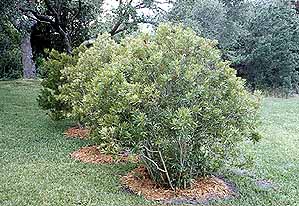Myrica cerifera

Southern Wax MyrtleMammal Browse: YesInvasive: No, but may spread by root suckers and seeds Toxicity: Not poisonous to livestock. Hardiness: USDA Zones 7-10 Uses: Myrica cerifera is considered by some to be an herbal remedy. It's used as an antibacterial, a diaphoretic or an irritable bowel relief. Southern bayberry (sometimes called candleberry, waxberry or wax myrtle) is not to be taken by pregnant women. Only the root bark is used in herbal preparations. Flower: April - June, insignificant Description: This broadleaf evergreen shrub or tree grows quickly to 15 to 20 feet high and wide. The leaves are glossy green and typically 1½ to 3 inches long and 1/3 to ¾ inches wide, sometimes bigger (4½ inches long and 2 inches wide). Inconspicuous flowers appear in early spring, followed by fruit in late summer through winter. The grayish-white fruits are small (1/8 inch wide), heavily coated with wax and massed in clusters on the stems of the previous season’s growth. Wax myrtle plants are either male or female. Only female plants bear berries. Growth Rate: Wax myrtle grows very fast, sometimes as much as 5 feet in height and width in a single growing season. Cultivation: Wax myrtles are not particular about soil, but they prefer good drainage and slightly acidic soils. Plant shrubs in partial shade to full sun. They do not require a lot of maintenance. Plants may be pruned (limbed up) to form an attractive small tree with a handsome gray, almost white bark. Wax myrtles are sensitive to cold. Cold symptoms include browning of leaves and sometimes defoliation, but stem tissue is not injured. Problems: Wax myrtles are tough, durable shrubs. They have no serious plant diseases or insect pests. Iron chlorosis (yellowing of the leaf tissue between the veins) is a problem in high pH soils. Native To: Southeastern United States Location(s) In Park: All Zones Date Entered: 09/01/2004
Photo Source: |
Back To NC Zoo Plant Identification